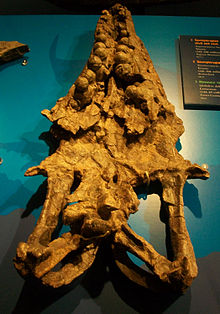Our website is made possible by displaying online advertisements to our visitors.
Please consider supporting us by disabling your ad blocker.
Globidensini
| Globidensini Temporal range: Late Cretaceous
| |
|---|---|

| |
| Skull of G. dakotensis (bottom view) in the Field Museum of Natural History, Chicago | |
| Scientific classification | |
| Domain: | Eukaryota |
| Kingdom: | Animalia |
| Phylum: | Chordata |
| Class: | Reptilia |
| Order: | Squamata |
| Clade: | †Mosasauria |
| Family: | †Mosasauridae |
| Subfamily: | †Mosasaurinae |
| Tribe: | †Globidensini |
| Genera | |
The Globidensini or Globidentatini are a tribe of mosasaurine mosasaurs, a diverse group of Late Cretaceous marine squamates. Members of the tribe, known as "globidensins" or "globidensine mosasaurs", have been recovered from North America, Europe, Africa and Asia.[1] The tribe contains the genera Globidens (the best studied genus by far), Carinodens,[2] Igdamanosaurus,[3][4] Harranasaurus[5] and Xenodens.[6] Features of the maxilla and digits make the placement of Carinodens and Xenodens in the tribe uncertain; some researchers have suggested that they may be more appropriately placed in the Mosasaurini.[6]
Towards the end of the Cretaceous, a series of adaptations allowed the highly specialized mosasaurs within the Globidensini, characterized by knob-like teeth,[7] to successfully reclaim the niche of the durophagous lifestyle. This niche had been unoccupied for most of the Mesozoic ever since the extinction of the placodonts and the durophagous ichthyosaur Grippia. The rarity of the Globidensini in the fossil record remains a mystery, perhaps it is due to habitat preference (deep water), some other form of taphonomic bias or due to the durophagous lifestyle not allowing the establishment of large populations in the first place.[8] In Angola, the disappearance coincides with the extinction of Inoceramus shells.[9]
The robust and globular teeth have on occasion been compared to the genera Prognathodon and Plesiotylosaurus, both of which sometimes are included within the tribe. Said genera are probably not as closely connected to Globidens as such an inclusion would suggest.[10]
The etymology of the tribe derives from the genus Globidens (Latin Globus = "globe" + Latin dens = "teeth").
- ^ "Fossilworks: Gateway to the Paleobiology Database". fossilworks.org. Archived from the original on 25 March 2022. Retrieved 17 December 2021.
- ^ Russel, Dale (1975). "A new species of Globidens from South Dakota, and a review of globidentine mosasaurs". Fieldiana Geology. 33 (13): 235–256.
- ^ Schulp, Anne S., et al. "New mosasaur material from the Maastrichtian of Angola, with notes on the phylogeny, distribution and palaeoecology of the genus Prognathodon." On Maastricht Mosasaurs. Publicaties van het Natuurhistorisch Genootschap in Limburg 45.1 (2006): 57-67. [1]
- ^ Lindgren, Johan. "Dental and vertebral morphology of the enigmatic mosasaur Dollosaurus (Reptilia, Mosasauridae) from the lower Campanian (Upper Cretaceous) of southern Sweden." Bulletin of the Geological Society of Denmark 52.17 (2005): e25. [2]
- ^ Kaddumi, Hani F. (2009). "A new durophagous mosasaur (Squamata: Mosasauridae) from the Maastrichtian Muwaqqar Chalk Marl Formation of the Harrana Fauna". Fossils of the Harrana Fauna and the Adjacent Areas. Amman: Eternal River Museum of Natural History. pp. 36–48. OCLC 709582892.
- ^ a b Longrich, N.R.; Bardet, N.; Schulp, A. S.; Jalil, N (2021). "Xenodens calminechari gen. et sp. nov., a bizarre mosasaurid (Mosasauridae, Squamata) with shark-like cutting teeth from the upper Maastrichtian of Morocco, North Africa" (PDF). Cretaceous Research. 123: 104764. doi:10.1016/j.cretres.2021.104764. S2CID 233567615.
- ^ Martin, J. E. 2007. A new species of the durophagous mosasaur, Globidens (Squamata: Mosasauridae) from the Late Cretaceous Pierre Shale Group of central South Dakota, USA. Pages 167-176 in Martin, J. E. and Parris D. C. (eds.), The Geology and Paleontology of the Late Cretaceous Marine Deposits of the Dakotas. Geological Society of America, Special Paper 427. (Globidens schurmanni)
- ^ Schulp, Anne S.; Jagt, John W. M.; Fonken, Frans (2004-09-10). "New material of the mosasaur Carinodens belgicus from the Upper Cretaceous of the Netherlands". Journal of Vertebrate Paleontology. 24 (3): 744–747. doi:10.1671/0272-4634(2004)024[0744:NMOTMC]2.0.CO;2. ISSN 0272-4634. S2CID 131741406.
- ^ Polcyn, Michael J.; Jacobs, Louis L.; Schulp, Anne S.; Mateus, Octávio (March 2010). "The North African Mosasaur Globidens phosphaticus from the Maastrichtian of Angola". Historical Biology. 22 (1–3): 175–185. doi:10.1080/08912961003754978. ISSN 0891-2963. S2CID 62882332.
- ^ Madzia, D., Cau, A. (2017). Inferring "weak spots" in phylogenetic trees: application to mosasauroid nomenclature Archived 2017-09-17 at the Wayback Machine. PeerJ 5:e3782
Previous Page Next Page


